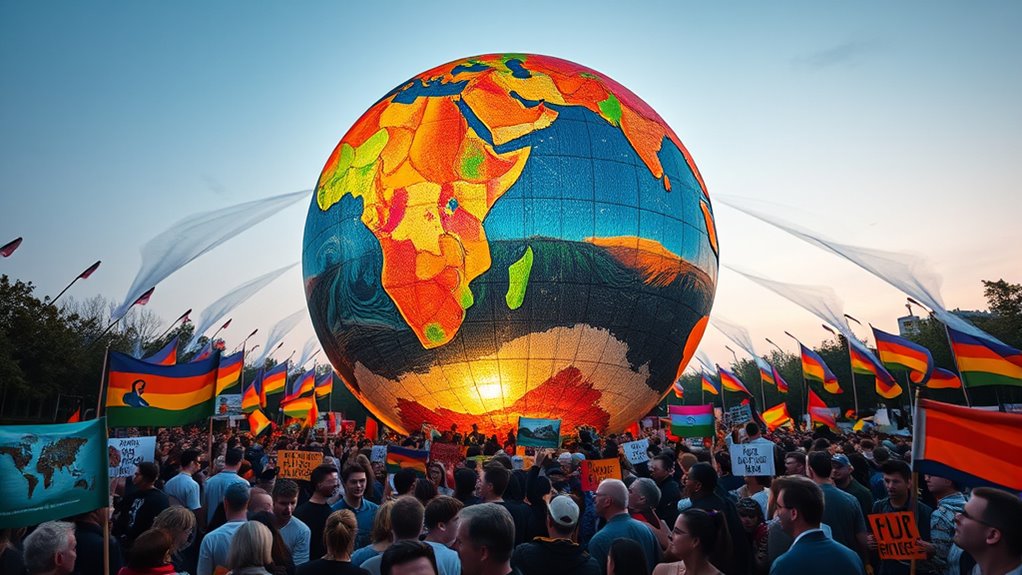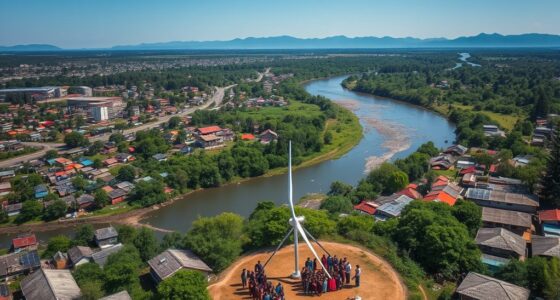Global climate agreements have evolved from the Kyoto Protocol’s binding emission targets to the Paris Agreement’s flexible national commitments. You see a shift toward shared responsibility, transparency, and technological innovation. Countries now prioritize renewable energy and carbon pricing to achieve global climate goals. This progress highlights international cooperation in addressing climate change. If you keep exploring, you’ll discover how these agreements continue shaping efforts for a resilient, sustainable future worldwide.
Key Takeaways
- The Kyoto Protocol was the first treaty binding developed nations to emission reduction targets, but faced criticism for limited participation.
- The Paris Agreement introduced nationally determined contributions (NDCs), emphasizing transparency and shared responsibility among countries.
- Both agreements aim to coordinate international efforts to limit global temperature rise below 2°C, ideally to 1.5°C.
- Advances in technology and data analysis support monitoring, reporting, and enhancing the effectiveness of climate commitments.
- Future climate agreements focus on strengthening renewable energy adoption, carbon pricing, and global cooperation for sustainable development.

Have you ever wondered how countries come together to tackle the urgent issue of climate change? It’s no small feat to coordinate efforts across nations with different priorities, economies, and environmental impacts. That’s where global climate agreements come into play. These treaties aim to unify countries around common goals, setting standards and encouraging actions to reduce greenhouse gas emissions. One of the most significant strategies within these agreements is implementing carbon pricing, which puts a financial cost on emitting carbon dioxide. By assigning a price to carbon, governments incentivize industries and businesses to cut emissions and adopt cleaner technologies. This approach not only discourages pollution but also generates revenue that can be invested in renewable energy projects. It’s a practical way to align economic incentives with environmental goals, making sustainability a core part of a nation’s development plan.
Alongside carbon pricing, countries are making renewable commitments—pledges to increase their reliance on clean energy sources such as wind, solar, and hydro power. These commitments are vital because transition to renewable energy reduces dependency on fossil fuels, which are the primary drivers of climate change. When nations set ambitious renewable commitments, they signal their dedication to fostering a sustainable future and encouraging innovation in green technologies. These pledges often come with specific targets, like reaching a certain percentage of renewable energy in the national grid by a particular year. Such commitments not only help cut emissions but also create new economic opportunities, jobs, and technological advancements. Additionally, international cooperation plays a crucial role in supporting developing countries to meet their renewable energy goals and adapt to climate impacts. Strengthening global collaboration can accelerate progress and ensure that no country is left behind in the transition to sustainability.
Looking back at the history of global climate agreements, the Kyoto Protocol marked a pivotal moment. It was the first major treaty that legally bound developed countries to reduce their emissions, but it faced criticism for limited participation and lack of enforcement. The 2015 Paris Agreement built on these lessons, bringing nearly every country on board with a more inclusive approach. Instead of fixed emission reduction targets, Paris introduced nationally determined contributions (NDCs), giving countries flexibility to set their own goals based on their circumstances. It also emphasized the importance of transparency and accountability, pushing nations to report their progress regularly. This agreement signified a shift toward collaborative effort and shared responsibility, recognizing that climate change is a global challenge that requires collective action. Additionally, advancements in data analysis by AI have started to play a role in monitoring and predicting climate trends, further supporting these international efforts. Leveraging technological innovations can significantly improve the effectiveness of climate policies and responses.
Today, the momentum from these agreements continues to grow. Countries are increasingly embracing carbon pricing systems and strengthening renewable commitments. The goal is to keep global temperature rise well below 2°C, ideally capping it at 1.5°C. While challenges remain, the evolving framework of global climate agreements reflects a widespread acknowledgment that coordinated action is essential. By working together, nations can leverage their strengths, share innovations, and make meaningful progress toward a sustainable, resilient planet.
Frequently Asked Questions
How Do Climate Agreements Impact Local Communities Financially?
Climate agreements can considerably impact your local community financially by promoting carbon offsetting projects and renewable incentives. These initiatives encourage investments in clean energy, creating jobs and boosting local economies. You might see increased funding for renewable energy sources and better infrastructure, which can reduce energy costs long-term. Overall, such agreements help your community grow sustainably while providing economic opportunities through environmentally friendly practices.
What Are the Enforcement Mechanisms for Climate Commitments?
Imagine you’re in a world where climate commitments are like a secret handshake. Enforcement relies on compliance mechanisms and carbon trading, which guarantee countries follow through. If they fall short, penalties or trade restrictions might apply, encouraging accountability. These mechanisms act as modern-day safeguards, keeping nations on track. Without strong enforcement, climate goals risk failure. So, it’s essential to have clear, effective compliance tools to turn commitments into action.
How Do Climate Agreements Address Developing Nations’ Needs?
You see climate agreements address developing nations’ needs by emphasizing sustainable development and equity considerations. They often include financial support, technology transfer, and capacity-building efforts to help these countries reduce emissions while pursuing growth. These agreements recognize that development priorities vary and seek to guarantee that developing nations can meet their needs without compromising environmental goals, fostering fairness and shared responsibility in tackling climate change.
What Role Do Non-State Actors Play in Global Climate Efforts?
Imagine a powerful chorus where everyone has a voice—that’s what non-state actors bring to climate efforts. You see, grassroots activism sparks change, while corporate influence can shape policies. Together, they amplify the call for action, often driving innovation and accountability. By acting beyond governments, these actors remind us that climate solutions aren’t just top-down; they’re a collective chorus, vital for meaningful progress in tackling climate change.
How Are Climate Agreements Adapted for Future Technological Advancements?
You should consider how climate agreements are designed to incorporate technological integration and innovation adaptation, ensuring they remain effective as new advancements emerge. By including flexible frameworks, agreements can evolve with future tech, encouraging countries to adopt cutting-edge solutions. This proactive approach allows for continuous improvement, making climate efforts more resilient and adaptive to rapid technological changes, ultimately strengthening global cooperation toward sustainable goals.
Conclusion
As you watch the Earth’s fragile tapestry of forests, oceans, and glaciers, remember that your choices ripple through this delicate balance. From Kyoto’s tentative steps to Paris’s ambitious promise, each agreement aims to steer us away from a dying horizon. Together, you and the world hold the power to turn the tide—transforming a future shadowed by climate change into a dawn of hope, where the planet’s vibrant life continues to flourish beneath a resilient sky.










